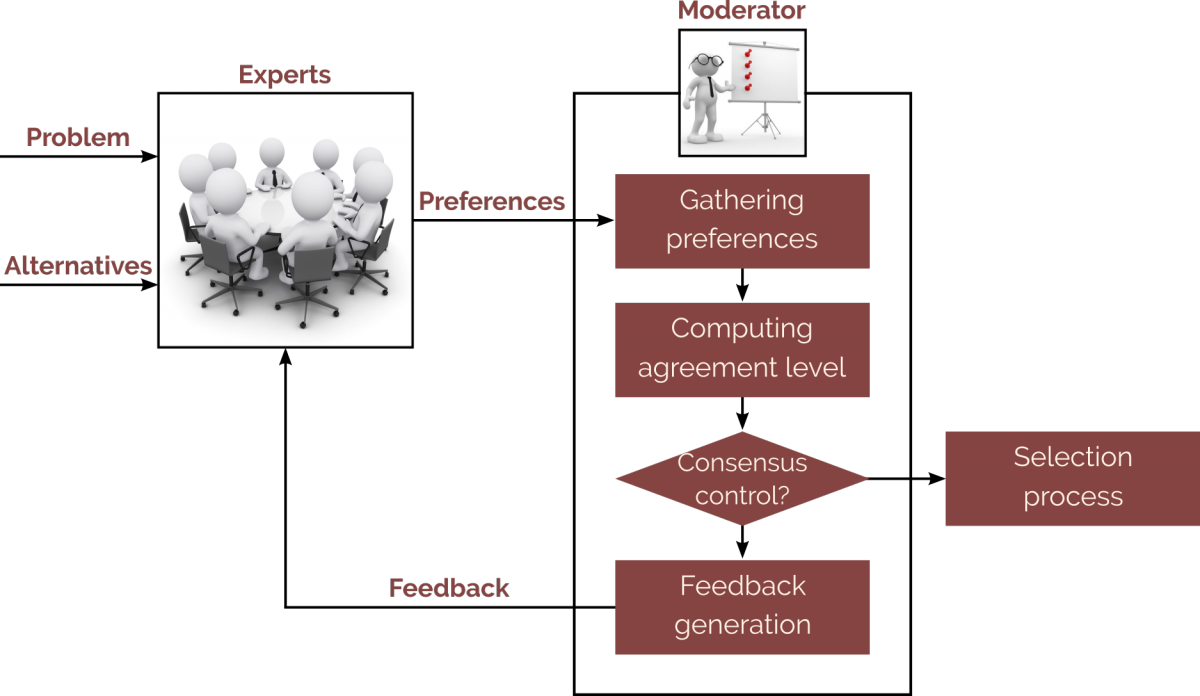The alternative selection process described in Group Decision Making (GDM) section does not guarantee that the solution achieved for the GDM is accepted by all experts in the group, since some of them might consider that their individual concerns have not been taken into account properly. In many real-life GDM problems, obtaining a solution which is highly accepted by all experts is crucial, therefore an additional phase called consensus phase or Consensus Reaching Process (CRP) is introduced into the resolution process for GDM problems.

Resolution process for GDM problems under consensus
The concept of consensus has been interpreted from different points of view, from total agreement (unanimity), which is usually difficult to achieve in practice, to more flexible interpretations. S. Saint and J.R. Lawson defined the term consensus as a "state of mutual agreement among members of a group, where all legitimate concerns of individuals have been addressed to the satisfaction of the group". J. kacprzyk and S. Zadrozny introduced the notion of soft consensus, based on the concept of fuzzy majority, which states that consensus exists when "most of the important individuals agree as to (their testimonies concerning) almost all of the relevant options". Flexible interpretations of consensus assume that it can be measured as different levels of partial agreement, which indicate how far the opinions of experts are from unanimity. Thus, an important subject of research in the field of consensus in GDM, is the definition of adequate consensus measures that compute the current level of group agreement from the individual preferences of experts. Consensus measures are usually based on the used of distance or similarity metrics to compute the closeness between opinions of experts, as well as aggregation operators to obtain a global consensus degree in the whole group from similarity/distance values previously computed.
Classically, a CRP is an iterative and dynamic process of discussion and modification of preferences by experts, with the aim of reaching a high level of collective agreement. Such a process is normally coordinated by a human figure, the moderator, who is responsible for supervising and guiding the discussion between experts.
A large number of consensus models have been proposed by different researchers during recent decades, to support CRPs in GDM problems defined in many different frameworks. Some of these consensus models have been implemented in the software framework AFRYCA for the simulation of CRPs with them. Most of the consensus models proposed in the literature follow a basic scheme whose main phases are described below:
- Consensus Measurement: Preferences of all experts, Pi, are gathered to compute the current level of agreement in the group, by using consensus measures.
- Consensus Control: The consensus degree computed in the previous phase is compared with a threshold value to decide whether it is enough or not. If the consensus degree is higher than such a threshold, then consensus is reached and the group moves on to the selection process (see Figures 1 and 2). Otherwise, it is necessary to carry out another round of discussion.
- Consensus Progress: A procedure is applied to increase the level of agreement in the following consensus round. Such a procedure has traditionally consisted of applying a feedback generation process, in which the moderator identifies experts' assessments which are farthest from consensus, and advises them to modify such assessments. This feedback mechanism has been considered in many consensus models. On the other hand, some other models do not incorporate such mechanisms, and instead they implement approaches that update information about the GDM problem (normally experts' preferences) automatically to increase consensus in the group without human expert intervention. AFRYCA includes implemented versions of consensus models that consider both types of mechanisms to seek consensus.

Scheme for CRPs with feedback mechanism for experts